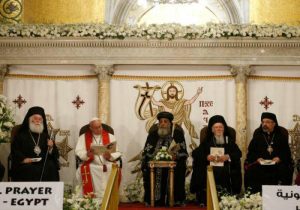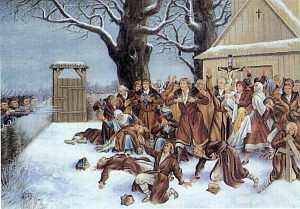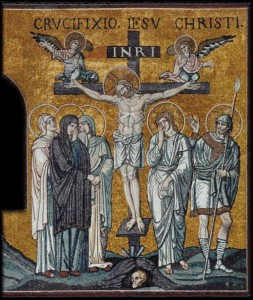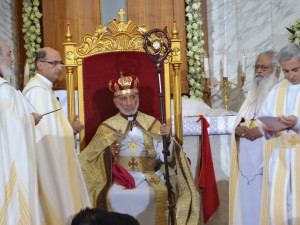 Today, the first time in history that the Patriarchs of Rome, Constantinople, & Alexandria (Greek & Coptic) have been in the same place, same time.
Today, the first time in history that the Patriarchs of Rome, Constantinople, & Alexandria (Greek & Coptic) have been in the same place, same time.
St Peter, St Mark and St Paul, pray for us.
May the Theotokos guide us to her Son.
 The Orthodox Church of Alexandria (Egypt and all of Africa) ordained a few women to the diaconate. His Beatitude Theodoros II, Pope and Patriarch of Alexandria and All Africa, did the ordination on February 17, 2017 in the Democratic Republic of Congo.
The Orthodox Church of Alexandria (Egypt and all of Africa) ordained a few women to the diaconate. His Beatitude Theodoros II, Pope and Patriarch of Alexandria and All Africa, did the ordination on February 17, 2017 in the Democratic Republic of Congo.
In a slight contrast, The Church of Greece officially “brought back” the female diaconate in 2004, though one Metropolitan had ordained a nun in 1986.
In this picture you see the women being tonsured a reader, which happens outside the altar (iconostasis) leading to being ordained deaconesses. A news brief is here.
Theologically in the Orthodox Church, ordination is not an ontological change. The Roman Church holds to a theology that says at priestly ordination the soul is changed ontologically. There is a hot debate in Roman Church about what happens to the man when ordained to the Order of Deacon (is there a change at the level of the soul?). That change happens when one receives the Mysteries of Initiation (scraments): baptism, chrismation Eucharist —one becomes a “new creation” in Jesus Christ. It may be more accurate to say that Pope Theodoros II consecrated but not ordained the women. In any event, this gesture is very significant and forward thinking and right.
Continuing in the ancient tradition Ordination, rather, is the setting apart for a specific task, for example as a reader, sub-deacon, deacon, priest, or bishop. Hence, the diakonia is lived according to rank: servant, elder, overseer. These women are being set aside for a specific task within the Alexandrian Church of Alexandria, a task which appropriately belongs to the order of deacons –the women were blessed into a minor order (cheirothesia). Yet, the exact nature of their diaconal ministry is unclear except to say they will be working for the mission of the Church. Also, absent from view is the liturgical text and rubrics used by the Alexandrian Pope. Some of the markers of this ordination are the towels and washing of the bishop’s hands, which are clearly pictured.
There is a Pan-Orthodox document (Consultation on Rhodes, 1988) stating that the church had, indeed, ordained females to the diaconate and recognized that, in some places, it had never fallen out of practice.
The Orthodox Church names women who fulfiled the ministry in the Order of Deacon and are saints: St Tatiana (January 12), St Olympias (July 25), and St Foebe (September 3).
 The Byzantine Catholic Church liturgically recalls Blessed Martyrs of Pratulin: men and boys killed on this date in 1874 defending the Byzantine Catholic Church in Russia. The martyrdom took place when the Tsar destroyed the last Greek Catholic eparchy in the empire, Chelm, in 1873 – 1875.
The Byzantine Catholic Church liturgically recalls Blessed Martyrs of Pratulin: men and boys killed on this date in 1874 defending the Byzantine Catholic Church in Russia. The martyrdom took place when the Tsar destroyed the last Greek Catholic eparchy in the empire, Chelm, in 1873 – 1875.
More can be read here on the Servants of God Wincenty Lewoniuk and 12 Companions.
September 1st is the Byzantine New Year 7525. Western Christians begin their new liturgical year on the First Sunday of Advent. The Greek Church, today.
Historically, “the First Ecumenical Council established that the Church’s year would begin on September 1st, continuing the practice of the Roman Empire at that time. For centuries, the beginning of the civil year coincided with the Church year, but later changed, first in western Europe, then in Russia in the time of Peter the Great.”
IN the Divine Liturgy we sing the following trope:
O Lord, Maker of the Universe, who alone has power over the seasons and times, bless this year with your bounty. Preserve our country in safety. Keep your people in peace. Through the prayers of the Mother of God, save us. (from the Troparion)
 A man who followed Christ to the priesthood and to the personal companionship in the spiritual life died recently. Jesuit Father Raymond Thomas Gawronski, 65, died after living with cancer on 14 April 2016. His most recent ministry was to serve as professor of dogmatics at St. Patrick’s Seminary and University in Menlo Park, California.
A man who followed Christ to the priesthood and to the personal companionship in the spiritual life died recently. Jesuit Father Raymond Thomas Gawronski, 65, died after living with cancer on 14 April 2016. His most recent ministry was to serve as professor of dogmatics at St. Patrick’s Seminary and University in Menlo Park, California.
I knew Father Gawronski as gifted in very many ways due to the natural gifts of his humanity and because of the integration of his intellect and life of prayer. All his friends and associates would say this. Most keenly he was nurtured by the Eastern Christianity and served as a Byzantine (Melkite) priest for the Eparchy of Newton.
In an interview with CNA, seminary rector Father Stevens said what he appreciated about Father Gawronski was the insistence he placed on integration of faith and reason: “we have to do a better job bringing together the intellectual and spiritual life.” He was speaking of the seminarians he was mentoring. Further, “That comes a lot from his work on von Balthasar. This recognition that the life of the mind and the life of the spirit cannot be seen as two separate things to be cultivated: and that was certainly apparent when he put together the spiritually program, but that’s how he approached everything. In his homilies, his spiritual direction, in his class, he just went back and forth between his life of prayer and his scholarship without skipping a beat, and I admire that so much.” Indeed, this is THE ONLY model of Christian living that’s tenable.
If you are inclined to read good theology then I would recommend Father Gawronski’s book, Word and Silence: Hans Urs von Balthasar and the Spiritual Encounter Between East and West. There is also: A Closer Walk with Christ: A Personal Ignatian Retreat.
May Father Gawronski’s memory be eternal!
 Today our Orthodox Christian brothers and sisters are observing their Paschal Triduum according to the Julian calendar. The beauty of our Church is the ability to allow different and venerable traditions to co-exist.
Today our Orthodox Christian brothers and sisters are observing their Paschal Triduum according to the Julian calendar. The beauty of our Church is the ability to allow different and venerable traditions to co-exist.
We can do nothing apart from the Paschal Mystery of Christ. Hence, it is key to keep in mind that the Cross and Resurrection is central to our Hope in communion with God. In this Mystery we come to know the transformative nature of Love. Regrettably, too many Catholics and dare I say, Orthodox, have forgotten the centrality of the Mystery.
Let us pray for our Orthodox brethren during these days.
“Today he who hung the earth upon the waters is hung upon a Tree,
He who is King of the Angels is arrayed in a crown of thorns.
He who wraps the heaven in clouds is wrapped in mocking purple.
He who freed Adam in the Jordan receives a blow on the face.
The Bridegroom of the Church is transfixed with nails.
The Son of the Virgin is pierced by a lance,.
We worship your Sufferings, O Christ,
We worship your Sufferings, O Christ,
We worship your Sufferings, O Christ,
Show us also your glorious Resurrection.”
~Antiphon XV, Holy Friday Matins
This is old news for some, but it bears sharing here because it opens up the valued question of communio. The Assyrian Church of the East, of the ancient Christian churches, has good news in their attempt to revision their ministry in the 21st century. Christine Chaillot wrote the following piece trying to explain the complexities of this particular church. Let us pray for the Christians in Iraq, Catholic and Orthodox as they make their way in the face of the Islamist regime. The communion of churches and how we witness to Christ in the error of war and ideology is going to make or break Christianity.
 On September 22, 2015, the journalist, John Burger [a New Haven, CT resident], entitled his article : «As Refugees Stream. Out of Middle East, One Exiled Church May Be Headed Back. Assyrian Church of the East elects a new leader, and they may be already building his home in war-weary Iraq.
On September 22, 2015, the journalist, John Burger [a New Haven, CT resident], entitled his article : «As Refugees Stream. Out of Middle East, One Exiled Church May Be Headed Back. Assyrian Church of the East elects a new leader, and they may be already building his home in war-weary Iraq.
The return of the Church of the East to Erbil to elect the new Catholicos-Patriarch is highly significant. In 1933 Mar Shimun XXIII Eshaia, the Catholicos-Patriarch of the Assyrian Church of the East was obliged to leave Iraq and went into exile in the USA where the see was established in Chicago. When his successor, Mar Dinkha IV, passed away on March 26 2015 after an incumbency of almost forty years, elections were organised and the Holy Synod chose Mar Gewargis III who was enthroned at St. John’s Cathedral in Erbil on Sunday, Sept. 27 2015. He had previously been Metropolitan of Iraq, Jordan and Russia. Born in Habbaniyah, Iraq and educated at the University of Baghdad, prior to his ordination as a deacon in 1980, Mar Giwargis taught English in several Iraqi schools. In 1981, he was elevated to Metropolitan of Baghdad and all Iraq. His long experience of life and politics in Iraq, with its accompanying political upheaval and displacement will be invaluable in steering the Church of the East.
The consecration of Catholicos-Patriarch Gewargis III was attended by an international array of bishops from the Church of the East, who travelled from the USA, Canada, Australia, Iran, Syria and Sweden (where the bishop is responsible for all Europe) and of course India where the Church of the East was the first Christian presence since the beginning of Christianity, in Kerala (south west India). Also present were representatives of several Churches from Iraq (among them the Chaldean Catholic Patriarch Mar Louis Sako and bishops, the Syrian Orthodox Patriarch Ephrem and bishops) and from abroad, including from the Vatican and from the World Council of Churches. Political personalities were also present, including a Chinese delegate, recalling the remarkable misssionary activity that the Church of the East conducted for almost a millennium across Iran, Afghanistan and Central Asia reaching Mongolia and China. Today, the Church of the East has a new internationalism, but is firmly rooted in Mesopotamia.
Christianity has been present in Iraq since apostolic times; its founders were St Thomas of the Twelve Disciples and Ss. Addai (Thaddaeus) and Mari of the Seventy Apostles. The first location of the see of the Church of the East was in Seleucia-Ctesiphon, then the Persian capital, near present Baghdad. In the 9th century the patriarchate moved to Baghdad and then through various cities in what is now northern Iraq and also northwest Iran. In September 2015 the see was transfered from Chicago to Erbil, the present capital of the Kurdistan Regional Government (KRG) administered region of northern Iraq, a move that returned to historic roots since Erbil, the capital of the kingdom of Adiabene, was a very early bishopric in the first centuries of the Christian era. Currently, a new patriarchal building (on a grand avenue and opposite a large, new mosque) is being built in Erbil, on land donated by the KRG authorities. At the time of the consecration of Mar Gewargis III, the construction had not yet been completed, but the extensive grounds should also accommodate auxiliary buildings, including a seminary and a print-shop.
As well as physical growth, there have been attempts to heal the schism between the Assyrian Church of the East and the Ancient Church of the East that erupted in the mid 1960’s. The patriarch of the Ancient Church of the East, Mar Addai, has resided in Bagdad since 1964. Talks prior to the patriarchal election aimed at reconciliation. Although the reunification of the two factions has not yet been realised, further negotiation to this end will continue in the future. The patriarchal election heralds a new era for the Church of the East and all Christians in Iraq and the Middle East. As hundreds of thousands of people stream from war-torn areas of the Near East and Africa into Europe and elsewhere —and Christian leaders are desperately trying to keep their flocks in their ancestral homelands— the return of the Church of the East to the KRG admininistered region of northern Iraq in order to have the see ‘back home’ and for the Catholicos-Patriarch to be close to his faithful and encourage them to stay in their traditional homeland is heroic and very Christian. The return of the Catholicos-Patriarch within their midst is celebrated with great joy by all the faithful of the Church of the East in Iraq and also by the diaspora communities.